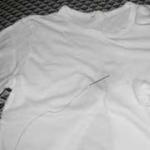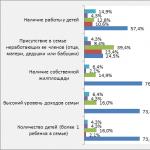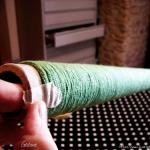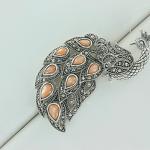A story about fashion in German. Methodological development in the German language on the topic "fashion"
Die Mode ändert sich immer sehr schnell. Die Kleidung, die heutzutage trendy und schick ist, kann in einigen Monaten unmodern, ausgefallen werden. Aber eines Tages in der Zukunft wird sie wieder Mode, weil es immer so war. Die Mode ist einerseits eine Sucht nach der Neuartigkeit. Andererseits machen viele Menschen Mode mit, weil sie Angst haben, von den anderen ausgelacht zu werden.
Fashion always changes very quickly. Clothing that is modern and elegant today may become out of fashion in a few months. But one day in the future it will become fashionable again, as it always has been. On the one hand, fashion is the desire for something new. On the other hand, many people follow fashion because they are afraid of being ridiculed by others.
Unsere moderne Mode ist mit den Jahreszeiten eng verbunden. In der Antik konnte die Mode Jahrhunderte lang unverändert bleiben. Es ist sehr schwer zu sagen, was in der Mode zeitlos ist oder zeitlos sein kann.
Our modern fashion is very connected with the seasons (seasons). In ancient times, fashion could remain unchanged for centuries. It is very difficult to say what in fashion exists or can exist outside of time.
In der modernen Welt gibt es viele Zeitschriften, die der Mode gewidmet sind. Es gibt auch weltberühmte Modehäuser, beispielsweise “Gucci”, “Armani”, “Versace”, etc. Für Modepapst hält man Paris, Frankreich.
In the modern world there are many magazines dedicated to fashion.. There are also world-famous fashion houses, for example, Gucci, Armani, Versace and others. Paris, France is considered the trendsetter.
Moderne Markenmode kann sehr teuer und nicht für alle zugänglich sein. Aus diesem Grund versuchen viele Hersteller, trendige Kleidung zu produzieren und diese relativ günstig oder sogar preiswert zu verkaufen.
Modern fashion brands can be very expensive and not accessible to everyone. For this reason, many manufacturers try to make fashionable clothes and sell them relatively inexpensively or even cheaply.

Es gibt Damenmode, Herrenmode und Kindermode. In jeder Richtung gibt es verschiedene Stile, und besonders viele Stiele bietet selbstverständlich Damenmode an. Die Damenkleidung kann elegant, modern, festlich, sportlich, für Strand, für Zuhause, für Business, etc. sein.
There is women's, men's and children's fashion. There are different styles in every direction, and, of course, women's fashion offers especially many styles. Clothing for women can be elegant, modern, dressy (holiday), sports, for the beach, for home, for business, etc.
Jeder Mensch kann immer seinen eigenen Stil wählen, ihm treu bleiben und sich dadurch wohl fühlen. Hier hängt alles üblicherweise vom persönlichen Geschmack ab.
Each person can always choose their own style, stay committed to it and thus feel good. It usually all depends on personal taste.
Die Mode ändert sich immer sehr schnell. Die Kleidung, die heutzutage trendy und schick ist, kann in einigen Monaten unmodern, ausgefallen werden. Aber eines Tages in der Zukunft wird sie wieder Mode, weil es immer so war. Die Mode ist einerseits eine Sucht nach der Neuartigkeit. Andererseits machen viele Menschen Mode mit, weil sie Angst haben, von den anderen ausgelacht zu werden.
Fashion always changes very quickly. Clothing that is modern and elegant today may become out of fashion in a few months. But one day in the future it will become fashionable again, as it always has been. On the one hand, fashion is the desire for something new. On the other hand, many people follow fashion because they are afraid of being ridiculed by others.
Unsere moderne Mode ist mit den Jahreszeiten eng verbunden. In der Antik konnte die Mode Jahrhunderte lang unverändert bleiben. Es ist sehr schwer zu sagen, was in der Mode zeitlos ist oder zeitlos sein kann.
Our modern fashion is very connected with the seasons. In ancient times, fashion could remain unchanged for centuries. It is very difficult to say what in fashion exists or can exist outside of time.
In der modernen Welt gibt es viele Zeitschriften, die der Mode gewidmet sind. Es gibt auch weltberühmte Modehäuser, beispielsweise “Gucci”, “Armani”, “Versace”, etc. Für Modepapst hält man Paris, Frankreich.
In the modern world there are many
Fashion magazines. There are also world-famous fashion houses, for example, Gucci, Armani, Versace and others. Paris, France is considered the trendsetter.
Moderne Markenmode kann sehr teuer und nicht für alle zugänglich sein. Aus diesem Grund versuchen viele Hersteller, trendige Kleidung zu produzieren und diese relativ günstig oder sogar preiswert zu verkaufen.
Modern fashion brands can be very expensive and not accessible to everyone. For this reason, many manufacturers try to make fashionable clothes and sell them relatively inexpensively or even cheaply.
Es gibt Damenmode, Herrenmode und Kindermode. In jeder Richtung gibt es verschiedene Stile, und besonders viele Stiele bietet selbstverständlich Damenmode an. Die Damenkleidung kann elegant, modern, festlich, sportlich, für Strand, für Zuhause, für Business, etc. sein.
There is women's, men's and children's fashion. There are different styles in every direction, and, of course, women's fashion offers especially many styles. Clothing for women can be elegant, modern, dressy (holiday), sports, for the beach, for home, for business, etc.
Jeder Mensch kann immer seinen eigenen Stil wählen, ihm treu bleiben und sich dadurch wohl fühlen. Hier hängt alles üblicherweise vom persönlichen Geschmack ab.
Each person can always choose his own style, remain committed to it and thus feel good. It usually all depends on personal taste.
- Latest news on the topic Fashion
- der Abend, - e - evening der Abendkurs, - e - evening course abends - evenings aber - but der Abschied, - e - farewell...
- The German language is rich in a wide variety of proverbs and sayings. The main difference between a proverb and a saying is that a proverb is always a complete, independent, often rhyming sentence...
- Twain wurde als Samuel Langhorne Clemens am 30.11.1835 in Florida (Missouri) geboren. Der Vater starb 1847 und Twain musste im Alter von zwölf Jahren eine...
- If life deceives you, don't be sad, don't be angry! On the day of despondency, reconcile yourself: Believe, the day of joy will come. The heart lives in the future; The present is sad: Everything is instantaneous, everything...
- On this page you will find interesting poems, rhymes and chants that you can use in your German lessons. Counting tables in German * * * Eins,...
- +Ä Die Adresse - address Aber - but, and der Affe - monkey das Alter - age guten Appetit - bon appetit der Arzt -...
- Einleitung: Was ist der Titel oder Inhalt der Grafik? Das Diagramm zeigt… Die Grafik stellt… dar. Die Tabelle zeigt... Das Schaubild zeigt... Die vorliegende Grafik...
- The gender of nouns (nouns) in German is particularly difficult for language learners, since the gender of German words often does not coincide with the gender of Russian words, and sometimes even...
Die ersten Kleidungsstücke wurden aus der beharrten Haut (aus den Fellen) von getöteten Tieren gemacht; die Urmenschen wickelten ihren Körper mit den Fellen um. Solche Kleidung schützte sie vor Kälte. Nachdem die Menschen sich mit der landwirtschaftlichen Tätigkeit zu beschäftigen begonnen hatten, erschien die Kleidung, die mit den modernen Kleidungsstücken verglichen werden kann. Vor ca. 6000 Jahren haben die Menschen gelernt, zu weben und zu spindeln.
Heutzutage ist die europäische Kleidung (Röcke, Hosen, Blusen, Hemde, Jacken etc.) besonders verbreitet. Immer selener ziehen die Menschen Nationaltrachten an. Aber trotzdem bleiben bei verschiedenen Völkern die besonders beliebten Kleidungsstücke erhalten. Die Chinesen tragen beispielsweise sehr gerne Jacken; moslemische Frauen haben sich den Schleiern angewöhnt, die ihren Körper vom Kopf bis zu den Füssen decken; indische Frauen tragen bequeme Saris etc.
Die Kleidungsstücke aus dem Pelz sind in kalten Regionen sehr beliebt, weil sie den menschlichen Körper ganz schön warm halten. Die Seide haben die Chinesen zum ersten Mal vor ca. 5000 Jahren hergestellt. Die Schuhe mit Absätzen und Plateau haben auch eine sehr lange Geschichte: die Plateausohlen der Strassenmädchen in Venedig des XV. Jahrhunderts sind bis 80 cm hoch gewesen. Die Kelten sind eventuell das erste Volk, das die Hosen zu tragen begann. Ungefähr zu dem gleichen Zeitpunkt erschien die ähnliche Kleidung auch in China.
Translation
The first clothing was the skins of killed animals, which ancient people wrapped around their bodies. Such clothing protected them from the cold. After people began to engage in agriculture, clothing appeared that can be compared to modern ones. About six thousand years ago, people learned to weave and spin yarn. From the fabrics they received, they learned to sew beautiful clothes.
Nowadays, the most common clothing is the European type (skirts, trousers, blouses, shirts, jackets, etc.). People wear their national costumes less and less. But still, different peoples retain the most popular types of clothing. For example, the Chinese willingly wear jackets; Muslim women are accustomed to wearing a veil that covers the body from head to toe; Indian women wear comfortable saris, etc.
Clothing made from animal skins is still very popular in cold areas because it retains human body heat well in the cold. Silk fabrics were first made by the Chinese about five thousand years ago. Shoes with heels and platforms also have a long history: the platforms of prostitutes in 15th-century Venice reached 80 centimeters in height. The ancient Celts may be the first people to wear trousers. This happened about two thousand years ago. Around the same time, similar clothing appeared in China.
If you liked it, share it with your friends:
Join us onFacebook!
See also:
The most necessary from the theory:
We suggest taking tests online:
The note “Clothing in German” is divided into several parts: underwear and homewear, outerwear, men's and women's clothing, accessories. And also in it you will find the names of fabrics and clothing parts in German. Well, as usual: a series of phrases on a given topic.
Lingerie and homewear
Outerwear in German

Men's and women's clothing


Basic verbs for this topic:
tragen - to wear: einen Rock tragen
anziehen - put on: einen Kleid anziehen
sich anziehen - to dress
ausziehen - remove: eine Hose ausziehen
sich ausziehen - to undress
sich umziehen - to change clothes
By the way: slightly different verbs are used with accessories - meaning to put on/take off - about that
And two more verbs similar to each other: passen- fit in size and stehen- suit. You will find examples of their use below.
Accessories in German
der Gürtel- belt
der Handschuhe (-e)- glove
die Krawatte- tie
die Tasche- bag
die Handtasche- women's handbag
die Armbanduhr- watch
die Schleife- bow
der Schal- scarf
die Mütze- a cap
der Hut- hat
der Sommerhut- summer hat
das Halstuch- handkerchief
The theme of “colors” works very closely with the theme of “clothing” - and it is in German -
But I’ll add a few more words about colors: geblümt- in a flower, gestreift- striped, getupft — speckled, kariert- in the box.
Das ist ein gepunktes Kleid. — This is a dress with small polka dots.
What are the clothes made of:
Fabric names in German
die Baumwolle - cotton
das Frottee - terry cloth
echtes Leder - genuine leather
das Leinen - linen
der Mohair - mohair
der Kattun - chintz
das Nylon - nylon
der Samt - velvet
die Wolle - wool
der Velours - velor
das Tuch - cloth
synthetischer Stoff - synthetics
Clothing details
der Knopf - button
der Druckknopf - button
das Knopfloch - loop
der Ärmel - sleeve
der Saum - border, hem
die Spitze - lace
der Reißverschluss - lightning
der Klettverschluss - Velcro
die Rüsche - frill
der Kragen - collar
das Schulterpolster - shoulder
das Revers - lapel
mit Gummibund - with elastic band
Clothes in German - phrases
Welche Größe haben Sie?- What is your size?
Wie finden Sie dieses Kleid?— How do you find this dress?
Es ist schön (modern, praktisch)— It’s beautiful (fashionable, practical).
Die seide läuft nicht ein und knittert nicht.— Silk does not shrink and does not wash.
Ihr Freund hat einen schicken neuen Anzug an.— Your friend is wearing a new chic suit.
Ich suche ein schickes Kleid für eine Party.— I'm looking for a luxurious dress for a party.
Das Kleid steht Ihnen sehr gut.— The dress suits you very well.
Ja, es passt ganz genau und ich sehe in dem Kleid sehr sclank aus.- Yes, it fits very well, and I look slim in it.
Diese Jeans ist zu eng.— These jeans are too tight.
Können Sie die Hose kürzer machen?— Could you shorten these trousers?
Ich habe einen Anzug von der Stange gekauft. — I bought a ready-made suit.
Sie kleidet sich mit Geschmack (Stil).— She dresses tastefully (fashionably).
Der Anzug passt ihm wie angegossen.— The suit fits him like a glove.
Kleider macht die Leute. - People meet you by their clothes.
Dieser Anzug ist reif für den Lumpensack. “It’s time to throw this suit in a landfill.”
Ich brauche eine passende Bluse zu diesem Rock.- I need a blouse to match this skirt.
Die Farben sind harmonisch.— The colors are in harmony.
Das karierte Kostüm macht dich älter, als du bist. — A checkered suit will make you grow up/spoil you.
Mir gefällt das Kleid nicht so gut. Ich finde, die Farbe macht dich blass.— I don’t really like this dress. I think its color makes you look pale.
Well, what about shoes? - you ask. I decided to write about it separately. Wait!






